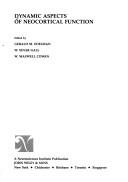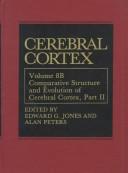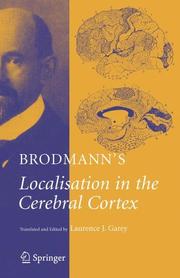| Listing 1 - 10 of 40 | << page >> |
Sort by
|

ISBN: 9780511541636 9780521852173 9780511388675 0511388675 0511387660 9780511387661 9780511384820 0511384823 0511541635 052185217X 1107176174 1281254452 9786611254452 0511386656 0511382995 Year: 2008 Publisher: Cambridge New York Cambridge University Press
Abstract | Keywords | Export | Availability | Bookmark
 Loading...
Loading...Choose an application
- Reference Manager
- EndNote
- RefWorks (Direct export to RefWorks)
The barrel cortex contains the somatosensory representation of the whiskers on the face of the rodent and forms an early stage of cortical processing for tactile information. It is an area of great importance for understanding how the cerebral cortex works because the cortical columns that form the basic building blocks of the cerebral cortex can be seen within the barrel cortex. In this advanced graduate and research level text, Kevin Fox explores three main aspects of the barrel cortex: development, sensory processing and plasticity. Initial chapters introduce the topic, describing those animals that have barrels, the functional anatomy of the system and the cellular and synaptic physiology of the cortical microcircuit. The book concludes with a chapter covering the numerous fields where the barrel cortex is used as a model system for solving problems in other areas of research, including stroke, angiogenesis and understanding active touch.
Cerebral cortex. --- Rodents --- Rodentia --- Mammals --- Brain mantle --- Cortex, Cerebral --- Cortex cerebri --- Mantle of brain --- Pallium (Brain) --- Telencephalon --- Nervous system.

ISBN: 0471805599 Year: 1984 Publisher: New York (N.Y.): Wiley
Abstract | Keywords | Export | Availability | Bookmark
 Loading...
Loading...Choose an application
- Reference Manager
- EndNote
- RefWorks (Direct export to RefWorks)
Cerebral cortex --- Cerebral Cortex --- Cortex cérébral --- physiology --- congresses --- Brain mantle --- Cortex, Cerebral --- Cortex cerebri --- Mantle of brain --- Pallium (Brain) --- Telencephalon --- physiology. --- Cortex cérébral --- congresses.
Book
ISBN: 0262314991 0262019302 1299773273 0262315009 9781461937111 1461937116 9780262314992 9781299773271 9780262019309 Year: 2013 Publisher: Cambridge, Mass. MIT Press
Abstract | Keywords | Export | Availability | Bookmark
 Loading...
Loading...Choose an application
- Reference Manager
- EndNote
- RefWorks (Direct export to RefWorks)
This study shows new ways of thinking about how the brain relates to the world, to cognition, and to behaviour. Based on foundations previously established it considers the implications of these ground rules for thalamic inputs, thalamocortical connections, and cortical outputs. The book argues that functional and structural analyses of pathways connecting thalamus and cortex point beyond these to lower centres and through them to the body and the world.
Thalamus. --- Cerebral cortex --- Brain mantle --- Cortex, Cerebral --- Cortex cerebri --- Mantle of brain --- Pallium (Brain) --- Optic thalamus --- Physiology. --- Telencephalon --- Brain --- Diencephalon --- Thalamus --- NEUROSCIENCE/General

ISBN: 0306415445 0306417553 0306420252 0306420406 0306421747 0306425033 0306428814 0306434776 0306436353 0306436485 0306446057 1475796242 1475796226 1475796307 1475796285 1461566185 1461566169 146156624X 1461566223 1475796218 1475796196 1461367069 1461538246 Year: 1986 Publisher: New York (N.Y.) : Plenum press,
Abstract | Keywords | Export | Availability | Bookmark
 Loading...
Loading...Choose an application
- Reference Manager
- EndNote
- RefWorks (Direct export to RefWorks)
Cerebral Cortex --- Cerebral cortex --- Brain mantle --- Cortex, Cerebral --- Cortex cerebri --- Mantle of brain --- Pallium (Brain) --- anatomy & histology. --- physiology. --- Telencephalon --- Monograph --- anatomy & histology --- physiology
Book
ISBN: 0826107273 9780826107275 9780826107268 0826107265 Year: 2015 Publisher: New York, NY
Abstract | Keywords | Export | Availability | Bookmark
 Loading...
Loading...Choose an application
- Reference Manager
- EndNote
- RefWorks (Direct export to RefWorks)
The Neuropsychology of Cortical Dementias addresses in depth the neuropsychological impact and features of the full range of cortical dementias. It examines the differential neuropathological and pathophysiological bases of these dementias and emphasizes their behavioral and cognitive aspects in assessment, diagnosis, and treatment. The book also presents the most advanced techniques and strategies for disease-specific treatment. Important legal/ethical issues and the role of caregivers in treating dementia patients are also covered. Featuring contributions from such diverse disciplines as neu
Dementia. --- Cerebral cortex. --- Neuropsychology. --- Neurophysiology --- Psychophysiology --- Brain mantle --- Cortex, Cerebral --- Cortex cerebri --- Mantle of brain --- Pallium (Brain) --- Telencephalon --- Aphrenia --- Aphronesia --- Athymia --- Dementias --- Brain --- Neurobehavioral disorders --- Psychoses --- Diseases
Book
ISBN: 9783031060939 Year: 2022 Publisher: Cham Springer International Publishing :Imprint: Springer
Abstract | Keywords | Export | Availability | Bookmark
 Loading...
Loading...Choose an application
- Reference Manager
- EndNote
- RefWorks (Direct export to RefWorks)
Cerebellum. --- Cerebral cortex. --- Neurosciences. --- Neural sciences --- Neurological sciences --- Neuroscience --- Medical sciences --- Nervous system --- Brain mantle --- Cortex, Cerebral --- Cortex cerebri --- Mantle of brain --- Pallium (Brain) --- Telencephalon --- Rhombencephalon
Book
ISBN: 303106092X 3031060938 Year: 2022 Publisher: Cham, Switzerland : Springer,
Abstract | Keywords | Export | Availability | Bookmark
 Loading...
Loading...Choose an application
- Reference Manager
- EndNote
- RefWorks (Direct export to RefWorks)
Cerebellum. --- Cerebral cortex. --- Neurosciences. --- Neural sciences --- Neurological sciences --- Neuroscience --- Medical sciences --- Nervous system --- Brain mantle --- Cortex, Cerebral --- Cortex cerebri --- Mantle of brain --- Pallium (Brain) --- Telencephalon --- Rhombencephalon --- Cerebel

ISBN: 128080386X 9786610803866 0387269193 0387269177 Year: 2006 Publisher: [New York, NY] : Springer,
Abstract | Keywords | Export | Availability | Bookmark
 Loading...
Loading...Choose an application
- Reference Manager
- EndNote
- RefWorks (Direct export to RefWorks)
This is the third edition of the translation, by Laurence Garey, of "Vergleichende Lokalisationslehre der Grosshirnrinde" by Korbinian Brodmann, originally published by Barth-Verlag in Leipzig in 1909. It is one of the major "classics" of the neurological world. Even today it forms the basis for so-called "localisation" of function in the cerebral cortex. Brodmann's "areas" are still used to designate functional regions in the cortex, the part of the brain that brings the world that surrounds us into consciousness, and which governs our responses to the world. For example, we use "area 4" for the "motor" cortex, with which we control our muscles, "area 17" for "visual" cortex, with which we see, and so on. This nomenclature is used by neurologists and neurosurgeons in the human context, as well as by experimentalists in various animals. Indeed, Brodmann's famous "maps" of the cerebral cortex of humans, monkeys and other mammals must be among the most commonly reproduced figures in neurobiological publishing. The most famous of all is that of the human brain. There can be few textbooks of neurology, neurophysiology or neuroanatomy in which Brodmann is not cited, and his concepts pervade most research publications on systematic neurobiology. In spite of this, few people have ever seen a copy of the 1909 monograph, and even fewer have actually read it! There had never been a complete English translation available until the first edition of the present translation of 1994, and the original book had been almost unavailable for 50 years or more, the few antiquarian copies still around commanding high prices. As Laurence Garey, too, used Brodmann’s findings and maps in his neurobiological work, and had the good fortune to have access to a copy of the book, he decided to read the complete text and soon discovered that this was much more than just a report of laboratory findings of a turn-of-the-twentieth-century neurologist. It was an account of neurobiological thinking at that time, covering aspects of comparative neuroanatomy, neurophysiology and neuropathology, as well as giving a fascinating insight into the complex relationships between European neurologists during the momentous times when the neuron theory was still new. Laurence Garey is a neuroscientist and professional anatomist, who has worked in brain research throughout his career, in the University of Oxford, the University of California at Berkeley, the University of Lausanne in Switzerland, Imperial College London, the National University of Singapore, and the UAE University at Al Ain. His interests have spanned the structure and development of the primate visual system and the human cerebral cortex, including morphological correlates of schizophrenia. Before embarking on a medical career, he had studied modern languages at university. He is interested in the history of neuroscience, and has translated several works from French and German, including another of Brodmann's works on anthropological aspects of brain anatomy, in collaboration with Guy Elston. He lives on the shore of Lake Geneva in Switzerland. .
Cerebral cortex. --- Brain --- Localization of functions. --- Brain function localization --- Cerebral localization --- Localization of cerebral functions --- Neurophysiology --- Phrenology --- Brain mantle --- Cortex, Cerebral --- Cortex cerebri --- Mantle of brain --- Pallium (Brain) --- Telencephalon --- Functional localization

ISBN: 0415192676 Year: 1999 Publisher: London New York Routledge
Abstract | Keywords | Export | Availability | Bookmark
 Loading...
Loading...Choose an application
- Reference Manager
- EndNote
- RefWorks (Direct export to RefWorks)
#PBIB:2005.1 --- Cerebrale cortex --- Cortex [Cerebral ] --- Cortex cerebral --- Ecorce cérébrale --- Hersenschors --- Psychiatrie [Neuro] --- Cerebral cortex --- Neuropsychology --- Neuropsychiatry --- Behavioral neurology --- Brain mantle --- Cortex, Cerebral --- Cortex cerebri --- Mantle of brain --- Pallium (Brain) --- Biological psychiatry --- Neurology --- Telencephalon --- Neurophysiology --- Psychophysiology
Book
ISBN: 9782889197668 Year: 2016 Publisher: Frontiers Media SA
Abstract | Keywords | Export | Availability | Bookmark
 Loading...
Loading...Choose an application
- Reference Manager
- EndNote
- RefWorks (Direct export to RefWorks)
One fundamental requisite for a comprehensive view on brain function and cognition is the understanding of the neuronal network activity of the brain. Neurons are organized into complex networks, interconnected through synapses. The main sites for excitatory synapses in the brain are thin protrusions called dendritic spines that emerge from dendrites. Dendritic spines have a distinct morphology with a specific molecular organization. They are considered as subcellular compartments that constrain diffusion and influence signal processing by the neuron and, hence, spines are functional integrative units for which morphology and function are tightly coupled. The density of spines along the dendrite reflects the levels of connectivity within the neuronal network. Furthermore, the relevance of studying dendritic spines is emphasized by the observation that their morphology changes with synaptic plasticity and is altered in many psychiatric disorders. The present Research Topic deals with some of the most recent findings concerning dendritic spine structure and function, showing that, in order to understand how brain neuronal activity operates, these two factors should be regarded as being intrinsically linked.
Dendrites. --- Pyramidal cell. --- Cerebral cortex. --- Synapses. --- Nerve endings --- Nerves --- Neural circuitry --- Neural transmission --- Synaptosomes --- Brain mantle --- Cortex, Cerebral --- Cortex cerebri --- Mantle of brain --- Pallium (Brain) --- Telencephalon --- Neurons --- Synaptic integration --- pyramidal cell --- Cerebral Cortex --- Dendrites --- Synapses
| Listing 1 - 10 of 40 | << page >> |
Sort by
|

 Search
Search Feedback
Feedback About UniCat
About UniCat  Help
Help News
News